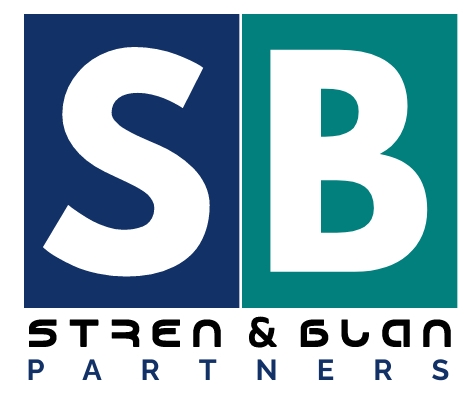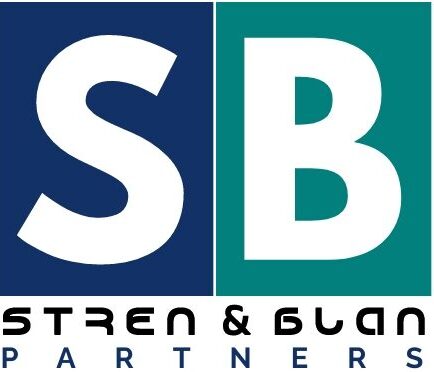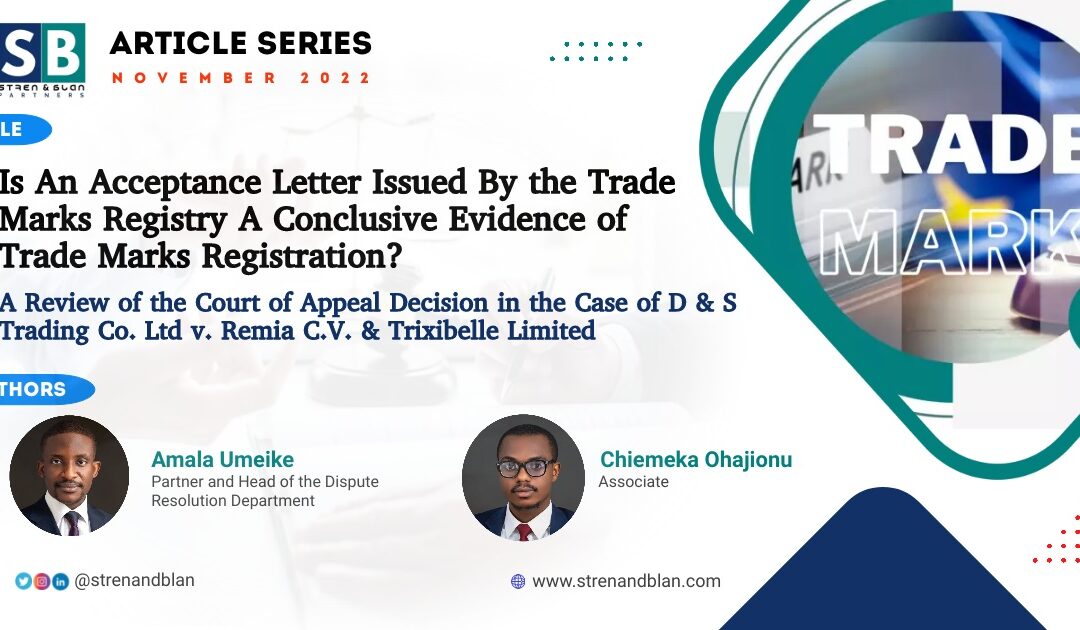BACKGROUND
The Court of Appeal (CA), Per Ebiowei Tobi JCA, held, among other things, that an acceptance letter amounts to trade markregistration when no certificate has been issued by the Trade Marks Registry in the case of D & S Trading Co. Ltd v. RemiaC.V. & Trixibelle (2019) LPELR-47628 (CA) at pages 29 to 33, paragraphs F-C.
The Court of Appeal hinged its decision on the ground that a letter of acceptance is a loud statement to the effect that the Applicant has satisfied the entire requirements for the registration and is only awaiting some administrative issues outside his control for the certificate to be issued and that same bears the trade mark registration number, the trade mark, amongst other details.
The counsel for the Appellant raised 5 issues for determination, all of which border on trade mark Infringement. The 3rd issue for determination is the crux of this article.
Whether an Acceptance Letter of a Trade MarkApplication is conclusive evidence of Trademark Registration within the provision of the Trade Marks Act CAP. T13 Laws of Federation of Nigeria 2004?
This article seeks to analyse the decision of the Court of Appeal in the above respect given the far-reaching consequences of the dictum of the Court in that case and its impact on trade marklitigations and intellectual property Law and Practice in general.
BRIEF FACTS OF THE CASE
The Appellant (as Plaintiff at the FHC) commenced an action against the Respondents (Defendants at the trial court) for the infringement of its registered trade mark “ROSA”. The Defendants also brought a counterclaim for the rectification of the certificate issued to the Plaintiff by the Trade Marks Registry so as to conform with the Nice Classification of Goods.
The Federal High Court (FHC) in Abuja, Per M.B Idris J (as he then was) dismissed the case of the Plaintiff and granted the Defendants’ counterclaim. The Plaintiff appealed to the Court of Appeal wherein it formulated the following issues for determination:
THE ARGUMENTS OF COUNSEL
The Appellant argued that the Respondents have no locus to file the Counterclaim in the Suit since the trade mark in question has not been registered. Counsel argued that the implication is that they do not have any proprietary right without the registration of the trade mark. Counsel submitted that concerning the registration of ROSA MAYONNAISE in class 29, the acceptance letter was not conclusive evidence of registration of trade mark.
The Respondents on the other hand submitted that a Trade MarkRegistration Certificate is not the only proof of registration of a trade mark. Counsel for the Respondent submitted that once the Applicant has complied with all the provisions of the Law for registration, an acceptance letter is issued and that means that what is left is entirely for the registry to issue the Certificate.
THE COURT OF APPEAL DECISION
The Court of Appeal reasoned with the position of the Respondents and held that once an applicant has complied with the entire requirements for the registration, and is only awaiting some administrative issues outside his control for the certificate to be issued and that the acceptance letter bears the trade markregistration number, the trade mark, amongst other details, then the letter is conclusive evidence of registration of a trade mark in favour of the Applicant.
OUR ARGUMENT
We agree and commend the Court of Appeal’s decision on issues 1, 2 4 and 4 as raised in the Appeal as it accords with the position of the law. However, we contend that the holding of the Court on issue 3 is not supported by the Trade Marks Act (TMA), and practice at the Trade Marks Registry. It is our view that if the Court had carefully analysed the provisions of the TMA as well as the steps necessary for the acquisition of a trade mark registration, it would have reached a different decision on the issue.
Steps and procedure towards trade mark acquisition in Nigeria
It is important to note that from the wordings of the TMA, nobody acquires the status of the “proprietor” unless that person has been registered by the Trade Marks Registry as a proprietor of the mark. The effect of registration is that the proprietor on enjoys the exclusive right to the usage of the trade mark in relation to those goods for which the trade mark was registered – section 5 of the TMA. This is of course with the exception as it relates to the Tort of Passing-Off as stated
A person who wishes to be a proprietor of a trade mark will apply for the mark, the same will be acknowledged by the Trade Marks Registry by the issuance of an acknowledgement form, after a search on the Trade Marks Registry’s database and upon confirmation that the application has complied with all the requirements of the law, an Acceptance Letter will be issued to the Applicant if the proposed mark is not contrary to any provisions in the TMA; the Acceptance Letter will bear the following information;
Upon issuance of the Acceptance Letter by the Trade MarksRegistry, the Registry will publish the trade mark in the Trade Marks Journal for possible objection by any party.
If there is opposition to the trade mark, such an opposition containing the grounds for the opposition will be filed at the Trade Marks Tribunal within two months of the publication of the trade mark in the Journal.
The Registrar of Trade Marks will notify the Applicant of any protest or opposition received. The Applicant may respond to such opposition within one month from the date of receipt of such notice from the Registrar by way of a Counter-Statement. An Applicant who failed to respond to the opposition received with his or her Counter–Statement will be deemed to have abandoned his or her application.
Upon presumption of abandonment, the Registrar can discontinue the registration process and issue a rejection letter. This is even after the initial Acceptance Letter has been issued to such an Applicant.
If there is no opposition, or there was an opposition and a Ruling was entered in favour of the Applicant, the Registrar, shall, unless the Application was accepted in error, proceed to register the mark as contained in section 22 of the Trade Mark Act. This portends that even when an Acceptance Letter has been issued and the huddle of opposition has been scaled by an Applicant, the Registrar can still refuse to register the mark on the grounds that the Acceptance Letter was wrongly issued ab initio.
For clarity, the law stated that the process of registration of a trademark begins after the time for opposition has elapsed, anddepending on whether there was an opposition which was resolved in favour of the applicant or there was no opposition.
The Registrar does not automatically issue the certificate to the applicant upon the expiration of the opposition period. The Applicant is still expected to apply to the registry to issue him the certificate by paying the necessary fees (known as sealing fees). If this is not done, the trade mark application may be abandoned. Section 22 (4) provides that if an Applicant does not conclude a registration process by a fault of his (such as not making payment for the sealing fees), the application may be abandoned by the Trade Marks Registry.
As stated earlier, no one acquires proprietary rights over a trademark unless it has been duly registered. The Certificate indicates the evidence of due registration and completion of all processes. It confers a right on the proprietor or the owner to use the trademark to the exclusion of every other entity.
Note, where any other person or entity successfully challengesthe Applicant in opposing a trade mark registration, the Registrar of Trade Marks will issue a letter of refusal to the Applicant. Again, this is even after the first issuance of the Acceptance Letter from the Trade Marks Registry before the opposition.
ANALYSIS
The Court of Appeal in the case under review stated that the Acceptance Letter from the Trade Marks Registry is a loud statement to the effect that the Applicant has satisfied the entire requirement for the registration only awaiting some administrative issues outside the control of the Applicant for the certificate to be issued….The only caveat is that it will be published for the general public. With the greatest respect to the Court, we beg to differ from the position of the Court regarding this issue.
The provision of Section 22(1) simply indicates that the Acceptance Letter is merely conclusive proof that the Applicant has fulfilled all requirements for the registration of the trademark; it is not proof that the trade mark has been registered. We submit that acceptance of a trade mark is simply a condition precedent for the publication of a trade mark in the Trade Marks Journal, and no authority exists that suggests this to be the contrary. The Acceptance Letter is merely a step towards registration the section does not in any way suggest an inference that upon acceptance the mark would be deemed registered. The decision of the Supreme Court in the Dyktrade Limited v. Omnia Nigeria Limited (SC/57/1995) and the case of Zeneca Ltd & Ors. vs Jagal Pharma Ltd (2007) LPELR-8384 (CA) referred to by the Court of Appeal, only addressed the effect of trade mark acknowledgement forms issued upon trademark application.
It is instructive to analyse the wordings of section 22 of the TMA at this point:
22(1). When an application for registration of a trade mark in Part A or in Part B of the register has been accepted, and either –
a. the application has not been opposed and the time for notice of opposition has expired; or
b. the application has been opposed and the opposition has been decided in favour of the applicant, the Registrar shall, unless the application has been accepted in error, register the trade mark in Part A or Part B, as the case may be.
2. Subject to the provisions of this Act relating to international arrangements, a trade mark, when registered, shall be registered as of the date of the application for registration, and that date shall be taken for the purposes of this Act to be the date of registration.
(3) On the registration of a trade mark the Registrar shall issue to the applicant a certificate of registration in the prescribed form sealed with the seal of the Registrar.
The TMA is clear, the Registrar of Trade Marks is statutorily mandated to begin registration of a mark after the opposition period, and after the issuance of the Acceptance Letter. See section 22(1)(b) of the Trade Marks Act. As stated; the Registrar SHALL, unless the application has been accepted in error, register the trade mark in Part A or Part B, as the case may be.
It is instructive to note that the word ‘SHALL‘ was used in respect of the act and performance of the Registrar. The word ‘SHALL‘ connotes the mandatory discharge of a duty or obligation, and when such a word is used in respect of a provision of the law that requirement must be met. See TabikInvest Limited v. G.T.B Plc. (2011) 17 NWLR (Pt 1276). Thus, by the provisions of section 22(3) the Registrar must issue a certificate of registration to the proprietor of the trade markupon the registration of the trademark. The import of this is that a certificate of registration is the proof of registration of a trademark and not an Acceptance Letter.
The TMA further provides that on registration of the trade mark, the Registrar shall issue the certificate in the prescribed form with the seal of the Registrar. It is important to note that the seal of the registrar is not affixed on the acceptance letter, but rather only on the certificate. For the Acceptance Letter, the Examiners sign the acceptance letters.
The implication of the above provisions is that proprietary right over a mark can only inure to an Applicant upon the registration of the trade mark at the Trade Mark Registry and suchregistration is only complete upon the issuance of a Registration Certificate affixed with the seal of the Registrar of Trade Marks and not an Acceptance Letter.
The Court of Appeal also reached its decision by stating that the Acceptance Letter has the registration number of the trade mark, the trade mark itself and the class in view it is registered. While we agree with these facts to an extent, we submit that the Acceptance Letter does not bear a registration number but rather an application number, indicative of the fact that the mark is still merely an application, it is upon obtaining a Certificate of Registration that the Trade Marks Registry will issue a new number which is the actual registration number of the trade mark. What the Acceptance letter carries up to the point of getting a certificate is the application number of the applicant and not the registration number.
We further submit that the Court of Appeal did not avert its mind to the fate of mark where an Opponent has successfully objected and won the opposition proceedings at the Trade MarksTribunal. The effect is that the Trade Marks Registry is mandated to send a letter of rejection on the application to the Applicant. If this is so, the poser, therefore, becomes how one can reconcile this situation with the decision of the Court that an Acceptance Letter amounts to registration.
Our humble submission is that until a trade mark is registered, the mark remains an application stripped of any legal rights whatsoever. It does not confer any legal right of the Applicant and cannot found any legal claim given that it has not gone through the process of Opposition and payment of the sealing fees as contemplated by Law.
CONCLUSION
An acceptance letter is an approval from the Registrar of Trade Marks that an application has met the basic requirements for registration save for opposition by third parties. An acceptance may be issued in error which is why the Act allows the Registrar to withdraw or correct an Acceptance Letter at any time before registration. Section 18(7). It does not have the effect of amounting to trade mark registration.
What is the remedy of a proprietor of a trade mark, whose mark, pending final registration at the registry has been infringed by a third party?
The right of such a person does not lie in an action for a trade mark infringement, because an infringement cannot occur in respect of a mark that is not registered and no person can sue or be entitled to remedies on an unregistered trademark. See the case of PATKUN INDUSTRIES LTD.v.NIGER SHOES MANUFACTURING CO. LTD (1988) 5 NWLR PT 139.However, the law provides that an owner of an unregistered trade mark may be infringed upon and remedies in action of Passing–Off goods against the 3rd party may be sought, see section 3 of the Trade Marks Act, thus, such a person can found his claim under Common Law.




